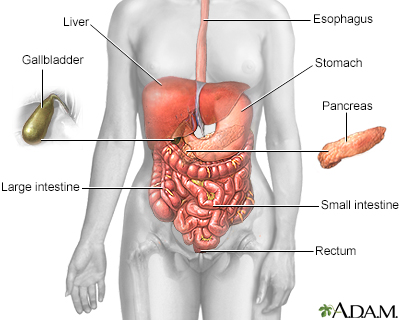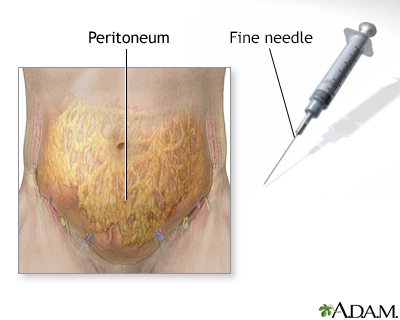Abdominal tap
Peritoneal tap; Paracentesis; Ascites - abdominal tap; Cirrhosis - abdominal tap; Malignant ascites - abdominal tap
An abdominal tap is used to remove fluid (ascites) from the area between the belly wall and the spine. This space is called the abdominal cavity or peritoneal cavity.

The esophagus, stomach, large and small intestine, aided by the liver, gallbladder and pancreas convert the nutritive components of food into energy and break down the non-nutritive components into waste to be excreted.

The peritoneum is the membrane lining the abdominal cavity.
How the Test is Performed
This test may be done in a health care provider's office, treatment room, or hospital.
The puncture site will be cleaned and hair clipped, if necessary. You then receive a local numbing medicine. The tap needle is inserted 1 to 2 inches (2.5 to 5 cm) into the abdomen. Sometimes, a small cut is made to help insert the needle. The fluid is pulled out into a syringe.
The needle is removed. A dressing is placed on the puncture site. If a cut was made, one or two stitches may be used to close it.
Sometimes, ultrasound is used to guide the needle. An ultrasound uses sound waves to make the image and not x-rays. It does not hurt.
There are 2 kinds of abdominal taps:
- Diagnostic tap -- A small amount of fluid (25 to 50 milliliters) is taken and sent to the lab for testing.
- Large volume tap -- Up to several liters may be removed to relieve abdominal pain and shortness of breath caused by a large volume of ascites.
How to Prepare for the Test
Let your provider know if you:
- Have any allergies to medicines or numbing medicine
- Are taking any medicines (including herbal remedies)
- Have any bleeding problems
- Might be pregnant
How the Test will Feel
You may feel a slight sting from the numbing medicine, or pressure as the needle is inserted.
If a large amount of fluid is taken out, you may feel dizzy or lightheaded. Tell your provider if you feel dizzy or lightheaded.
Why the Test is Performed
Normally, the abdominal cavity contains only a small amount of fluid if any. In certain conditions, large amounts of fluid can build up in this space.
An abdominal tap can help diagnose the cause of fluid buildup or the presence of an infection. It may also be done to remove a large amount of fluid to reduce belly pain or shortness of breath.
Normal Results
Normally, there should be little or no fluid in the abdominal space.
What Abnormal Results Mean
An exam of abdominal fluid may show:
- Cancer that has spread to the abdominal cavity (most often cancer of the ovaries)
- Cirrhosis of the liver
- Damaged bowel
- Heart failure
- Infection
- Kidney disease
- Pancreatic disease (inflammation or cancer)
Risks
There is a slight chance that the needle could puncture the bowel, bladder, or a blood vessel in the abdomen. If a large quantity of fluid is removed, there is a slight risk of lowered blood pressure and kidney problems. You may receive certain IV medicines after the test if you are at high risk for this problem. There is also a slight chance of infection.
References
Alarcon LH. Paracentesis and diagnostic peritoneal lavage. In: Vincent J-L, Moore FA, Bellomo R, Marini JJ, eds. Textbook of Critical Care. 8th ed. Philadelphia, PA: Elsevier; 2024:chap E10.
McNaught C. Practical procedures and patient investigation. In: Garden JO, Parks RW, Wigmore SJ, eds. Principles and Practice of Surgery. 8th ed. Philadelphia, PA: Elsevier; 2023:chap 10.
Solà E, Ginès P. Ascites and spontaneous bacterial peritonitis. In: Feldman M, Friedman LS, Brandt LJ, eds. Sleisenger and Fordtran's Gastrointestinal and Liver Disease. 11th ed. Philadelphia, PA: Elsevier; 2021:chap 93.
Version Info
Last reviewed on: 8/12/2024
Reviewed by: Jenifer K. Lehrer, MD, Gastroenterologist, Philadelphia, PA. Review provided by VeriMed Healthcare Network. Also reviewed by David C. Dugdale, MD, Medical Director, Brenda Conaway, Editorial Director, and the A.D.A.M. Editorial team.
